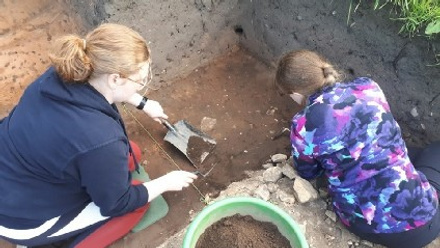Join Mercian Archaeological Services CIC in the beautiful Yorkshire Dales for this week-
As well as offering the very best in archaeological training and support, this training excavation is tailored towards enabling attendees to fulfill the requirements of the Archaeological Skills Passport.
The beautiful village of Bainbridge was formerly the administrative center of the medieval Forest of Wensleydale, and the magnificent Bolton Castle near Leyburn dominates the valley to the east. A Roman fort looms large over the village of Bainbridge on the eastern side.
The site of the excavation is overlooked by a Late Bronze Age to Early Iron Age Slight Univallate Hillfort. This fort occupies the high ground at the top of a steep slope on the southern side of the site.
We will be concentrating our excavations on the possible medieval manorial complex to the north of this fort, which has been identified from earthworks and recently discovered pottery (see below).
The area is famous not only for its beautiful landscape, but also its world-famous cheese, and as the backdrop to the television series ‘All Creatures Great and Small’.
Suitable for all levels from beginner to experienced digger.
For those wishing to develop their skills, for students and post-
What You Will Learn
You will receive training and experience in many techniques of excavation, including many Core Skills listed in the Archaeological Skills Passport:
- Handtools (Trowel etc)
- Handtools (Spade, Mattock etc)
- Site Formation Processes
- Stratigraphic Excavation
- Context Sheet Recording
- Site Photography
- Dumpy Level and Staff
- Archaeological drawing
- Artifact Recovery, Recording & Storage
- Site Safety
You Will Receive the Following
- All techniques are taught and experienced throughout the week, a mixture of theory sessions and hands on training from our Archaeological experts.
- Every attendee will be taught to excavate.
- Delegates will be taught archaeological drawing methods.
- Delegates will also receive training and experience in measuring and recording heights with a dumpy level.
- Topics covered in the classroom sessions will include site formation and processes, stratigraphic excavation, context sheets, drawing and photography, alongside a Pottery Identification Training seminar.
- Total Station training and surveying seminar and practical session.
- Lectures are accompanied by ‘hand-
outs’. These will be made available to attendees to download via a file- share. The details for access are provided prior to the field school. The files can be downloaded and are for students to keep. Mercian aim to be an environmentally friendly company and this helps us to work towards reducing our environmental footprint. - This course is suitable for people of all archaeological abilities from beginner wishing to take their first step, to experienced diggers wishing to take the next step, and from university students and post-
graduates needing more experience, to retired people wanting to fulfil a life’s ambition… all are welcome and will be treated equally… the experience is tailored to the individual through hands on personal supervision. - Field days include lunch (sandwiches) provided by caterers which will be eaten in our welfare area in the field.
- On-
site toilet facilities are provided. - All equipment is provided, although you are welcome to bring you own trowels etc (more details when you have booked).
Evening Field Visits
A tour around Brough Roman Fort, Bainbridge.
About the Site
The name Bainbridge comes from its location at the place where the “Cam High Road”, a Roman Road crossed the river Bain. To learn more about the Cam High Road see the webpage http://www.outofoblivion.org.uk/record.asp?id=424.
A Roman fort overlooked this crossing and a settlement grew around the fort named ‘Virosidum’.
The modern village is overlooked by the remains of this fort -

